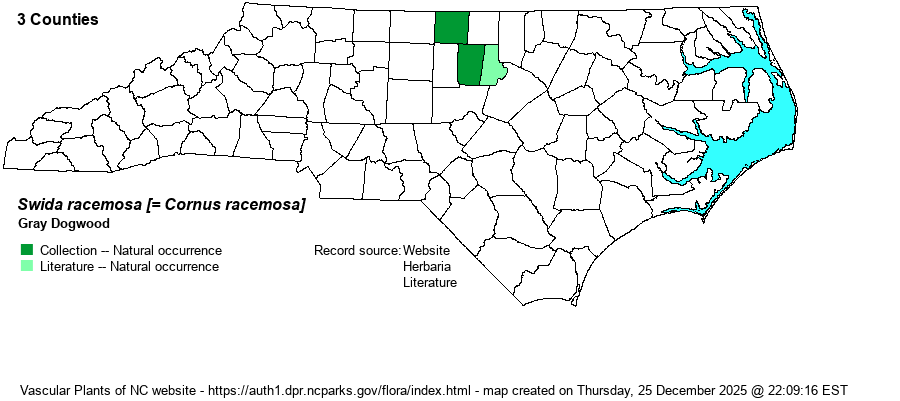| Author | (Lamarck) Moldenke | |
| Distribution | A few counties in the northeastern Piedmont. Considered to be native at these sites, though as a few records are from fencerows and wooded edges, and the sites are at the southern edge of the range, there may be some question as to its provenance in the state.
This dogwood has a wide range to the north of NC. It ranges from Canada south mainly to PA, western VA, and northern AR, with a few scattered records south to northern NC.
| |
| Abundance | Very rare; known from only about three or four sites, in Orange, Durham, and Caswell counties. This is a State Special Concern species. | |
| Habitat | In the state it is mainly found on the edges of wet hardwood forests or floodplains. One site is along hedgerows/fencerows between fields, in a floodplain, and another is along the edge of a poorly drained wet hardwood forest. | |
| Phenology | Blooms mainly in May, and fruits in August and September. | |
| Identification | This is a fairly small shrub, at least for a dogwood, growing only to about 6-8 feet tall. It has opposite, deciduous leaves that are narrower than other dogwood species, with a longer and tapered tip; leaves average about 2-2.5 inches long. The leaves are somewhat hairy, especially below, and are quite pale below, as well. The inflorescence clinches the identification; instead of a broad and flattened cluster of white flowers, it is somewhat conical or pyramid-shaped. And, the mature fruits are white, and not blue as in similar species. Though the species is known to be thicket-forming farther north in its range, in NC it is rare enough that only scattered individuals or at least small numbers are seen at a given site. | |
| Taxonomic Comments | Weakley (2020) names this genus as Swida, following recommendations of several recent references.
| |
| Other Common Name(s) | Gray-stemmed Dogwood, Northern Swamp Dogwood, Panicle Dogwood | |
| State Rank | S1 | |
| Global Rank | G5 | |
| State Status | SC-V | |
| US Status | | |
| USACE-agcp | | |
| USACE-emp | | |

